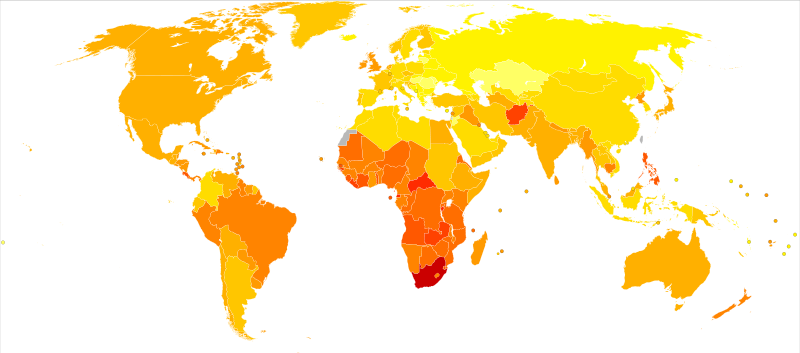Road-traffic pollution and asthma – using modelled exposure assessment for routine public health surveillance (7 page pdf, International Journal of Health Geographics, Oct. 14, 2004)

Age-standardised disability-adjusted life year (DALY) rates from Asthma by country (per 100,000 inhabitaants)
Key Quotes:
“almost 50% of NO 2 is thought to be produced by vehicles and much particulate matter is produced by diesel exhaust fumes”
“Heavy traffic flow has also been shown to increase childhood asthma admissions.. those living within close proximity to a road are also at an increased risk of hospitalisation with asthma”
“[public health]Policy implications might include routing of traffic, construction of bypasses, congestion reduction schemes, utilisation of non-fossil fuel cars and possibly even the location of schools”
“A monitoring system would use estimates of air pollution from road traffic which would be linked to data on asthma obtained from routine systems, such as hospital admissions, attendance at accident and emergency departments or primary care consultations or to data from periodic surveys on health, including asthma prevalence”
“[exposure assessment]comparing asthma prevalence in areas designated as high and low pollution areas, using distance from main roads as a proxy for exposure to road traffic pollution, using traffic counts to estimate exposure, using vehicular miles travelled and using modelling approaches which can take into account a number of variables”
“meteorological conditions can alter dispersion of pollutants. It is well known that cold weather conditions trap air close to the ground, prolonging the duration of the time pollutants remain close to where they were produced”
“Part IV of the Environment Act 1995 requires a local authority to designate an Air Quality Management Area (AQMA) covering any part of its administrative area where air quality objectives are not likely to be achieved by, or at any point beyond, the relevant objective's target date at locations where the general public might reasonably be exposed.. Local authorities are not statutorily obliged to meet the objectives, but they must show that they are working towards them”
“A routine surveillance system recording spatial variation in pollutant levels..would allow local policy decisions concerning the routing of traffic around residential areas or schools and plans to reduce congestion to be made with knowledge of the implications of the decision on the health of the local population”
Related articles
- Traffic pollution may raise emphysema risk, study finds (nationalpost.com)
- Traffic Pollution Tied to Increased Emphysema Risk (nlm.nih.gov)
- Breast Cancer Linked to Traffic Pollution (doyourpart.com)
- Cleaning the air with smart growth (switchboard.nrdc.org)
- Air pollution alters immune function, worsens asthma symptoms (eurekalert.org)
- Asthma and Pollution Increase The Suicide Rate (socyberty.com)


No comments:
Post a Comment